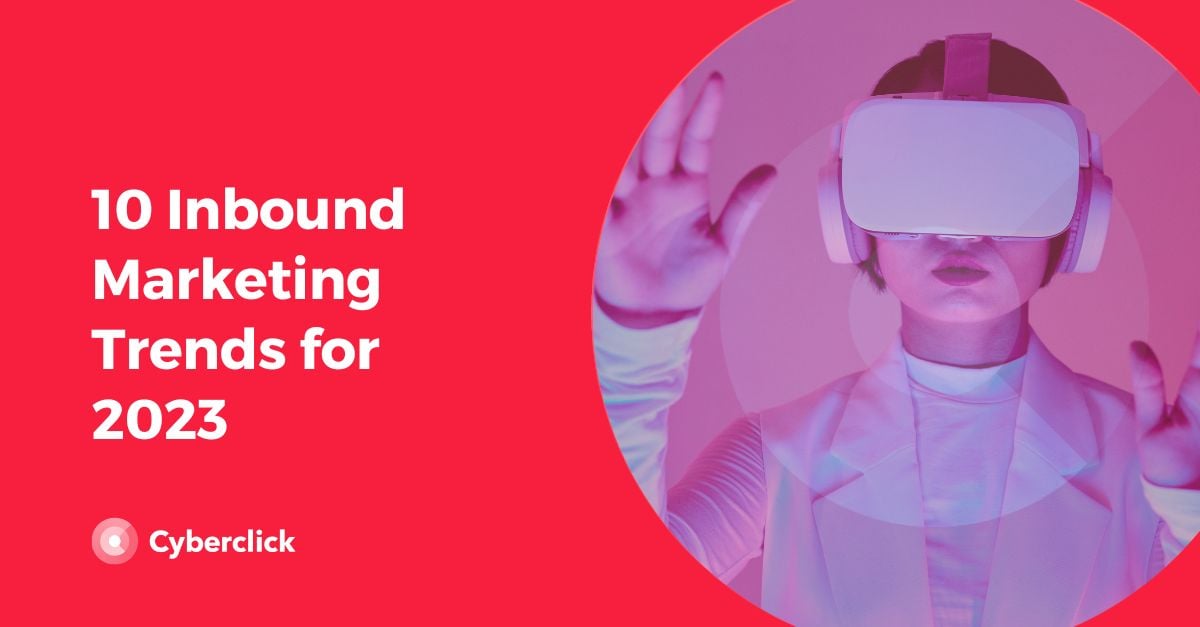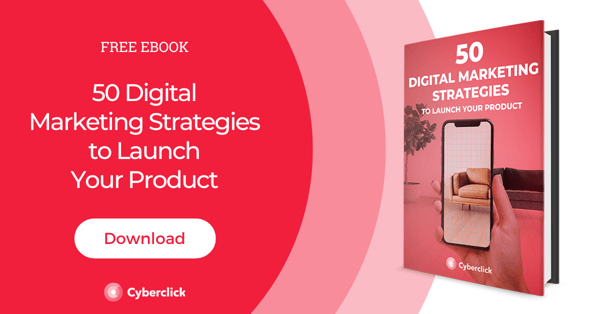Inbound marketing is based on attracting users to your brand by offering them value. This basic premise has evolved over the years, as the technological possibilities for attracting new customers, accompanying them through the conversion funnel and building loyalty increased. To keep you up to date, let's take a look at the biggest inbound marketing trends for 2023.

What Inbound Marketing Trends Will Dominate in 2023?
1. Short Video Content
Short videos are one of the digital marketing trends that have grown in recent years. According to HubSpot's marketing industry trends study, more than half of marketers using this format planned to increase their investment this 2023. In addition, short-form video has the best ROI of all social media strategies.
Originally, short-form video became popular with a younger audience through platforms such as Vine and TikTok. But today this format reaches all age groups and demographics through platforms like Instagram, YouTube and Facebook. All kinds of brands have jumped on the bandwagon, from dental clinics to air conditioning installation companies.
We already have several years of data analysis and optimization of short video results, so the time has come to refine strategies and combine organic and paid short videos on platforms such as TikTok, Instagram Reels, Tumblr, YouTube and Pinterest.
2. Podcasts and Audiobooks in Inbound
Video is not the only content format available to marketers. Audio, through podcasts and even audiobooks, can be a good way to attract inbound traffic and to accompany leads further down the conversion funnel.
Podcasts can be a very powerful inbound marketing channel for brands that focus on educating consumers, want to reach a larger audience, and are looking to encourage audience engagement.
This format is booming and the numbers prove it:
-
66% of people prefer podcasts to TV.
-
58% prefer podcasts to social networks.
-
96% like podcasts more than newspapers.
-
74% of people listen to podcasts to learn new things.
3. Evergreen Inbound Content Strategy
Content marketing has been one of the key inbound marketing trends for 25 years and will remain so for a long time to come. But to achieve the best results and return on investment in content marketing in 2023, let's focus on timeless or "evergreen" content.
Evergreen content is content that continues to provide value over time, with few or no updates. Typically, these are pieces of content that explain a topic in detail. Although they may require a certain amount of time and resources to create, their great advantage is that they continue to provide benefits for many years, so the return on investment is excellent.
Betting on content creation as a pillar of inbound marketing in 2023 can bring many advantages to brands, such as:
-
Paid media, email marketing and sales teams are a high cost for brands, which also increases over time. In contrast, content marketing, especially through evergreen content, is much more cost-effective.
-
New artificial intelligence tools help us identify valuable search terms and create targeted content for them to generate more leads.
-
Content increases both reach and interaction achieved with social media. To make the most of this channel, it is necessary to publish new content on a regular basis.
4. Ungated vs. Gated Content
When planning your content strategy for 2023, it’s important to decide whether you want to focus on gated or ungated content.
Gated content is "hidden" behind a form, i.e. the user must leave their information (like contact details) in order to access it. This strategy allows you to take advantage of your content to generate leads, but it offers fewer benefits in terms of search engine positioning and could also dissuade some of potential customers.
On the other hand, ungated content or open content is publicly accessible. This type of content helps us to improve SEO and brand awareness and build trust with your audience.
Of course, the two types of content are not mutually exclusive. In many cases, the optimal strategy is to leave much of the content out in the open, but to create some high-value pieces of content to use as gated content that helps you obtain leads. For this strategy to be effective, focus on creating landing pages that are highly engaging for your target audience.
5. Social First Content to Attract Leads
For an increasing percentage of consumers, the go-to site for resolving their questions is no longer Google but TikTok. Users seek advice from people they perceive to know, rather than from corporate websites. This covers everything from current events to skin care products.
Potential customers' research process spans different platforms, formats, and creators. They are looking for exceptional educational and entertainment videos and review comments to get other people's opinions.
For marketers, this means it's time to focus on social-first content, or content that is consumed directly on social networks and encourages the user to leave a comment. A Twitter thread, a 200 word post on LinkedIn or a TikTok video are examples of this trend.
For the best results, find a unique tone and style and try to create native content for each platform rather than reposts. Also, don’t forget to include calls to action focused on interactivity rather than traffic.
6. Using Video Throughout the Customer Journey
Video is an extremely versatile format, which you can use throughout the customer journey to increase conversions.
-
In the acquisition phase, video can help convert visitors into leads and leads into customers. For example, you can include a company introduction video on your home page, create video tutorials of your products, or use videos to communicate the latest news.
-
In the adoption phase, videos are used to show the value of your product, for example through expert reviews, webinars, or case studies.
-
In the loyalty phase, branding videos can help you turn your customers into brand ambassadors with content such as trailers, tips, company culture videos, and behind-the-scenes footage.
-
Video can also be a format to create evergreen content and get results for a long time, combining two inbound marketing trends in one.
7. Webinars
The pandemic was the final push for webinars. Now that this format has become popular among a wide variety of brands, think about how to organize webinars that stand out and achieve your objectives.
The biggest challenges of this format are getting attendees to stay until the end and having webinar attendees convert into leads or customers. Here on some tips on how to do this:
-
If you have organized a webinar before, analyze the results and identify the main changes you need to introduce. Was the length adequate for the expectations of your audience? Did the topic bring value?
-
Think about how to interact with people throughout the webinar to deliver a memorable experience. It can be as simple as running a poll with questions at regular intervals and asking the audience to participate.
-
Use the live chat feature to receive and answer questions from the audience and encourage interaction.
-
Offer rewards to users who stay connected throughout the webinar, for example, the opportunity to participate in a raffle.
8. B2B Brands Using TikTok in Their Inbound Strategies
Although TikTok may not be the first channel we think of when talking about B2B marketing, the truth is that B2B brands get more interaction and ROI on this social network than B2C brands. According to HubSpot data, 58% of B2B marketers planned to increase their investment in TikTok, compared to 49% of B2C marketers.
Therefore, we will likely see more and more tech and B2B companies on TikTok. This channel will be used to target through practical tips and tricks in an easy-to-consume format.
Another interesting B2B marketing trend on TikTok is the use of influencers to create co-branded or sponsored content, as third-party content generates more trust than content coming directly from a brand. This is not only a great opportunity for brands, but also for agencies that can offer the necessary tools, services, and training to work with TikTok.
9. Automation and Growth in Revenue Operations
HubSpot's recent State of Media & Content Planning Report showed that 78% of media planners use automation. Thanks to tools from HubSpot itself and other companies in the industry, marketers can automate key aspects of their work and use the time gained to improve customer experience and brand results.
We believe marketers will continue to find new and creative ways to use automation in their day-to-day work and for the benefit of their marketing organization. There will also be a continued need for revenue operations (RevOps) as we face a hectic marketplace where companies will need to be able to pivot quickly.
10. Which Inbound Actions Work Best for B2B and B2C Companies?
Let's wrap up this review of inbound marketing trends in 2023 by looking at what will be the most effective actions according to the type of company.
For B2B companies, HubSpot highlights the following:
-
The combination of inbound marketing and SEO is more effective in B2B than in B2C.
-
B2B brands get better ROI from inbound marketing and SEO in general.
-
These types of brands are more likely to use blogs, case studies, white papers, and interviews in their content.
-
LinkedIn is much more effective for B2B brands.
-
B2B brands are more likely to prioritize SEO over brand collaborations.
For their part, B2C companies should take note of the following:
-
B2C brands get better ROI with short-form and native advertising.
-
For B2C brands, voice search optimization, virtual and augmented reality, influencer marketing, podcasts and short-form content are more effective.
-
B2C brands' marketing budgets are more likely to increase next year.
-
Physical ads, such as billboards, are more effective in B2C.
-
B2C brands are more likely to use podcasts and checklists.
-
B2C brands are increasing their investment in Twitch.
-
B2C marketers are more likely to prioritize brand partnerships over SEO.
Finally, among the strategies that work for both B2B and B2C brands, we highlight social media, content marketing, segmented social ads, influencer marketing, and TikTok.
AI-Driven Business Digital Strategy Consultant en Cyberclick. Experta en ecommerce, experiencia de usuario (UX), inbound marketing y estrategias de CRO orientadas a maximizar las conversiones. Acompaña a las empresas en la integración de la IA en su negocio y en la toma de decisiones digitales para impulsar crecimiento y eficiencia.
AI-Driven Business Digital Strategy Consultant at Cyberclick. Expert in ecommerce, user experience (UX), inbound marketing and CRO strategies focused on maximising conversions. She helps companies integrate AI into their business and make better digital decisions to drive growth and efficiency.






Leave your comment and join the conversation